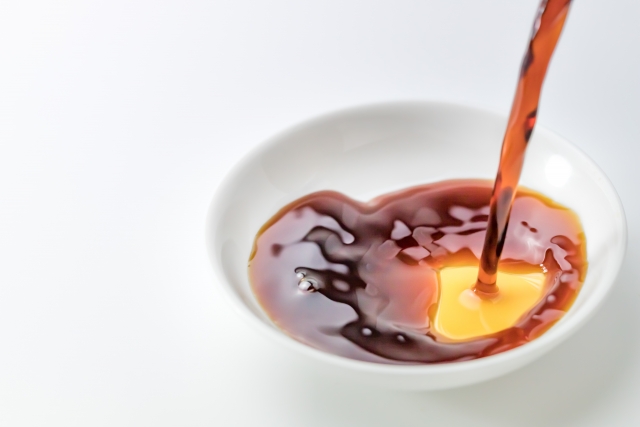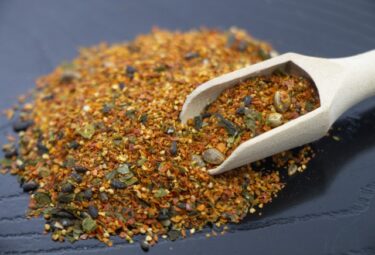Soy sauce is a seasoning unique to Japan and is used in most Japanese dishes. Also, sashimi and sushi are eaten with soy sauce.
The raw materials are soybeans, wheat, and salt, which are fermented with Jiuqu.
The taste is salty, but it contains umami ingredients that are decomposed from soybean and wheat proteins. The color is reddish brown.
Wheat is used as a raw material, but the protein contained in wheat is decomposed during fermentation and does not remain. Most people with wheat allergies can take soy sauce.
What is Soy Sauce and can I eat it?
Materials of Soy Sauce
Soybeans, wheat, salt, Aspergillus
| Low-gluten※ | Low FODMAPs | |||
| for Vegetarian |
| Food supermarket | Convenience store | Drug store |
※Since the protein contained in the raw material of soy sauce is decomposed into amino acids during the manufacturing process, almost no gluten remains in the product.
Gluten-free soy sauce which wheat is not used is avilable.
There are several types of Soy Sauce
Soy sauce is a seasoning usually used in Japan, and general soy sauce in a 500 ml PET bottle is available at all food supermarkets and convenience stores for $ 2. Also, soy sauce is found in almost every household in Japan.
Today’s sauce has been used in Japan for 400 to 500 years, and in the 18th century it was exported to Europe via the Netherlands, and there is a record that it was used in the court cuisine of Louis XIV.

Currently, Japanese households consume 5 liters of soy sauce annually. This does not include those used in mentsuyu and processed foods. Also, in Japan, the chances of cooking at home are decreasing, so the consumption of soy sauce is decreasing year by year.
On the other hand, soy sauce is exported to more than 50 countries, and there are soy sauce factories in 7 countries overseas.
Soy sauce is a salty seasoning, and 100 ml contains 15 to 17 g of salt. Also, salty soy sauce has a reddish brown color. This is the color of a substance called melanoidin, which is formed by the reaction of amino acids with sugar contained in the raw material decomposed by the enzyme of Jiuqu. Melanoidin has antioxidant, anti-cancer, and the effect of delaying the rise in blood sugar levels after a meal.
Jiuqu is used to make soy sauce. As for Jiuqu, different bacteria are used for each soy sauce manufacturers. Therefore, even the same type of soy sauce has a slightly different taste depending on the manufacturer.
There are more than 1000 companies that make soy sauce in Japan. If you go to a local city in Japan, you can meet soy sauce that can only be obtained there.
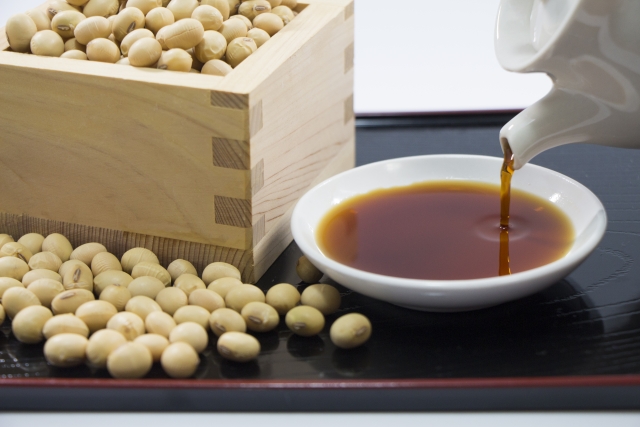
Soy sauce can be roughly divided into five types.
Koikuchi soy sauce (Rich type soy source)
The most common soy sauce, which accounts for 80% of production. It is made using the same amount of soybeans and wheat as raw materials. In addition to salty taste, it has deep umami, mellow sweetness, refreshing acidity, and bitterness that tightens the taste. It is used for both cooking and tabletop use.
Usukuchi soy sauce (Light type soy source)
It is a light-colored and salty soy sauce. The raw material uses more wheat than soybeans. It is often used in Japanese cuisine when the color or aroma of the ingredients are willing to not be changed. It is mainly produced in western Japan and accounts for 13% of soy sauce production.
Tamari soy sauce (Super rich type soy source)
It has a rich umami taste, a unique aroma, a dark color, and a little viscosity. Most of the ingredients are soybeans, and wheat is rarely used. It is often used when eating sushi and sashimi. When heated, it produces a beautiful redness, so it is also used for cooking such as teriyaki, and for processing such as tsukudani and rice crackers. It is mainly made in the Chubu region.
Saishikomi soy source (Soy sauce brewed twice)
This soy source is re-brewed by adding soybeans, wheat, and aspergillus sprinkle to the aged salty soy sauce. The color, taste, and aroma are so rich. It is used for sashimi, sushi, cold tofu, etc., as well as for soup. It is mainly produced in the San-in region and the Kitakyushu region. Saishikomi means brewed twice.
White soy source
It is a lighter color soy sauce than Usukuchi soy sauce. Most of the ingredients are wheat. The taste is pale but sweet and has a unique aroma. It is used for soups that make the most of the light color and aroma, dishes such as chawanmushi, rice crackers, and pickles.
Try to use Soy Sauce!
How much ?
$ 2, 500ml pet bottle (General products)
Where can I get Soy Sauce?
Food supermarkets, convenience stores etc.
Precautions when using Soy Sauce
Not gluten-free but very little gluten left
Soy sauce is a seasoning used in almost all Japanese dishes. For those who care about the fact that wheat is used as a raw material, let’s take a closer look at soy sauce and gluten.
The raw materials for soy sauce are soybeans, wheat, and salt. Soybeans are steamed, and wheat (brown wheat) is roasted and then crushed. If you sprinkle Jiuqu on it, it will increase in about 3 days. When salt water is added to this and aged for 6 months to 2 years, the enzyme of Jiuqu bacteria decomposes the components of soybeans and wheat to produce soy sauce. Soy sauce is made by slowly squeezing this and sterilizing the obtained liquid by heating.
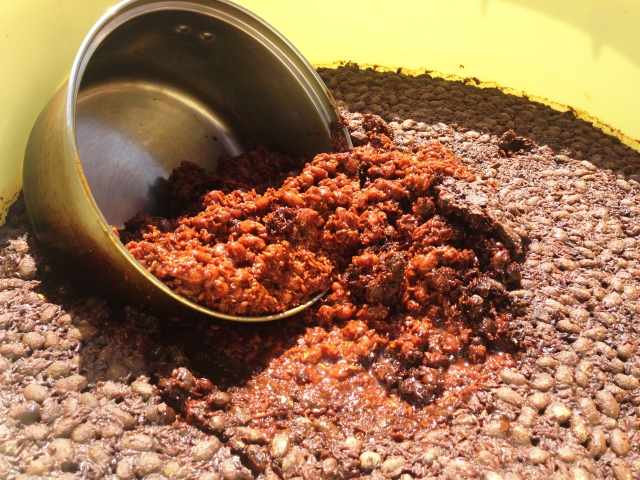
The proteins contained in soybeans and wheat are decomposed into amino acids during the aging process, so they do not remain in the form of proteins in soy sauce.
For people with soy or wheat allergies, protein is an allergen, but in most cases it’s okay to take it because the protein allergen isn’t broken down, says Japanese food allergy experts.
Informal data on the amount of gluten contained in sauce is said to be 10 ppm or less. For those that are used in small amounts as seasonings, it’s probably okay.
However, according to the FDA’s gluten-free notation rules, soy sauce made from wheat cannot be labeled as gluten-free. It is up to you to decide for yourself whether to eat soy sauce dishes.
Gluten-free soy sauce made without using wheat as a raw material is also on sale.
When you eat sashimi or sushi, you eat it with soy sauce, but you can bring your own gluten-free soy sauce to the restaurant. If you want to use gluten-free soy sauce in a restaurant, it’s probably okay.
However, you should stop asking whether gluten-free soy sauce is used or not in a Japanese restaurant. Unless the restaurant offers a gluten-free menu, gluten-free soy sauce is not be used.
Contains alcohol
Since soy sauce is fermented during the manufacturing process, it originally contains about 2% alcohol. Alcohol may be added to cheap soy sauce. The reason for adding is to prevent the growth of mildew.
Japanese writer’s comment for Soy Sauce
Gluten and alcohol may be the ingredients of soy sauce that need attention. There is soy sauce made without using wheat as a raw material.
You can get it in Japan at a big food supermarket. Recommended for those who are affected by small amounts of gluten.
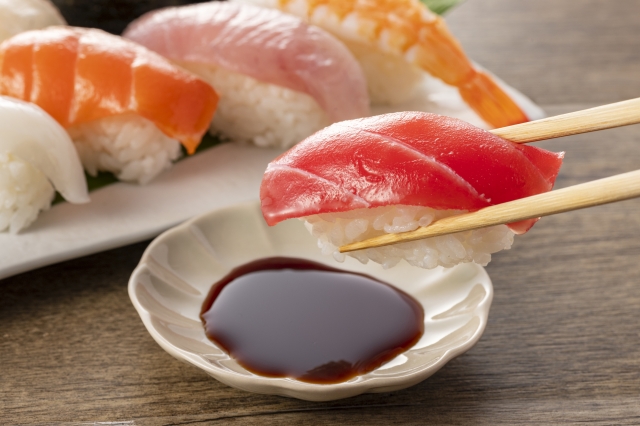
https://www.kikkoman.co.jp/kikkoman/halalsoysauce/index.html (Japanese page)
https://www.kikkoman.co.jp/products/product/K055005/index.html (Japanese page)
https://www.ichibiki.co.jp/product/soy-sauce/11895_1/ (Japanese page)
Some sauce is halal-certified and does not contain alcohol. This is not available at ordinary food supermarkets, and you need to purchase it at a grocery store that sells halal foods or online.
- Kikkoman Halal soy sauce
https://www.kikkoman.co.jp/kikkoman/halalsoysauce/index.html (Japanese page) - Chiba soy sauce, Halal Kochikuchi soy sauce
https://www.chibashoyu.com/english/products.html

